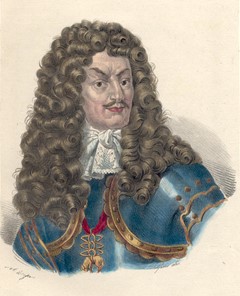Tracking down Raimondo Montecuccoli in Europe
General Raimondo Montecuccoli continues to accompany us on our virtual journey both in and around Modena and across Europe. Churches, museums, archives and libraries conserve the memory of this great condottiere who had a major influence on the story of the 1600s and who became so European that Italians almost forgot about him.
The importance of this personality can also be deduced from the vast iconography that carries his likeness in the portrait style of the full-blown 1600s school to be found right across Europe. One interesting portrait is on show at Pavullo’s Palazzo Comunale, the town hall: painted by an unknown local artist in the late 1600s, it portrays Raimondo in the martial and peremptory guise of a fully-armed condottiere. In Modena, at its Palazzo Comunale, is one of the best known paintings of Montecuccoli, the one by Girolamo Vannulli, a brilliant interpreter of the Italian figurative style of the 1700s.
Instead, in the Paradisino church, we find the altar of Sant'Antonio, bestowed in the 1670s as a votive offering by Raimondo Montecuccoli to the Church of Santa Margherita, the original location of the work, while Raimondo’s parents, Galeotto and Anna Bigi, were buried in the monumental Church of San Pietro, finished in 1506.
There are also several works showing Raimondo’s life as a condottiere at the Imperial court. At Vienna’s Kunsthistorishes Museum is a remarkable painting, cut down to an oval, in which Raimondo is wearing armour with on top the Golden Fleece, the symbol of the prestigious order of chivalry that reproduces the ram’s fleece of legend, granted by the royal houses of Austria and Spain. Raimondo was awarded this decoration by the King of Spain in 1666.
Another full-length portrait is to be found at the Museum Hafnerbach, again in Austria, where a white marble bust and various paintings portray other members of the Montecuccoli family including Princess Margarethe, Raimondo’s wife.
At Vienna’s Military History Museum, in the majestic atrium that serves as the “Room of the Condottieri” are marble statues representing General Montecuccoli and other illustrious military heads of the Hapsburg Empire and the Austro-Hungarian reign. This museum also keeps the field marshal’s baton used by Raimondo at the Battle of Saint Gotthard against the Turks.
Of enormous value are the literary works the General left us – including the important Treatise on War, written during his long imprisonment in Sweden and his On the War Against the Turks in Hungary from 1670, with much studied and highly appreciated translations produced in Germany, France and Spain. The manuscripts of his works are kept in various places around Europe: in Vienna’s War Archives and National Library, where we can find the original manuscript of his Military Tables and Axiomatic Tables of War, and in Modena’s Este Library which keeps On Battles. Other writings are kept at the Vatican Apostolic Library, while the state archive of Brno in the Czech Republic keeps important correspondence from Raimondo, his wife and his family.
During Raimondo Montecuccoli’s long life his diplomatic activities at the courts of the Central European and Scandinavian capitals were far from negligible. His acute observations, his descriptions of personalities, his insight into political machinations, all of this in his writings which was particularly successful in his volume Aphorisms, revealed the rich cultural milieu which inspired Montecuccoli.
In 1680, when Raimondo died in Linz – having followed the Imperial Court which had fled Vienna because of an outbreak of plague – his viscera were interred in the Church of the Cappuccini, while his corpse was taken to Vienna, where, on the 4 November, it was buried at a solemn funeral in the presence of the Emperor and the whole of the Court at the Am Hof Church.
Thanks to his acute political sensitivity, intellectual finesse and a shrewdness born of the grand strategy, Raimondo had lived enough to take in just what Europe and the sweeping changes of the 17th century really meant. His writings constitute an extraordinary, abundant testimony of this.
